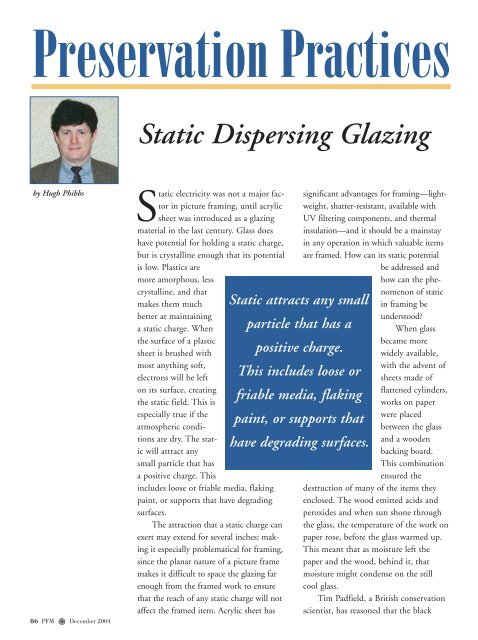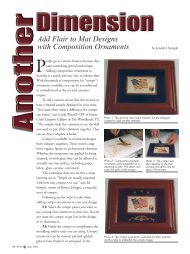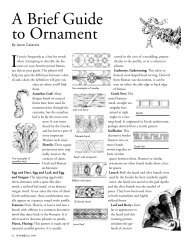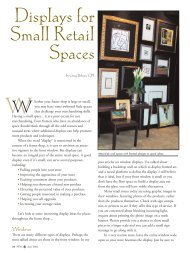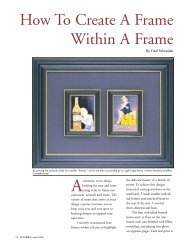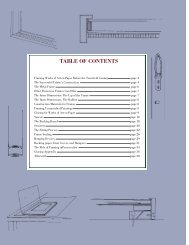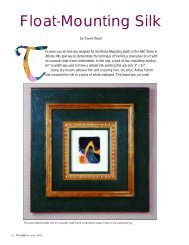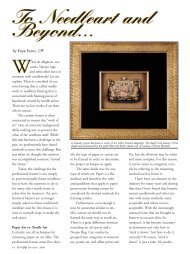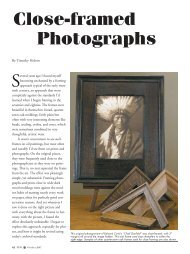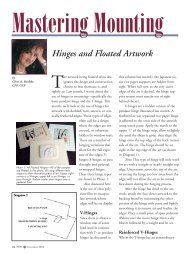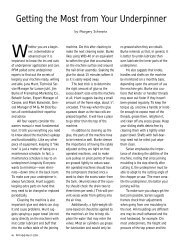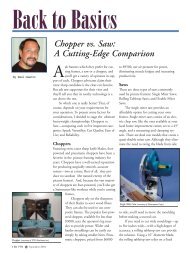Static Dispersing Glazing - Picture Framing Magazine
Static Dispersing Glazing - Picture Framing Magazine
Static Dispersing Glazing - Picture Framing Magazine
You also want an ePaper? Increase the reach of your titles
YUMPU automatically turns print PDFs into web optimized ePapers that Google loves.
Preservation Practices<br />
by Hugh Phibbs<br />
86 PFM _ December 2004<br />
<strong>Static</strong> <strong>Dispersing</strong> <strong>Glazing</strong><br />
<strong>Static</strong> electricity was not a major factor<br />
in picture framing, until acrylic<br />
sheet was introduced as a glazing<br />
material in the last century. Glass does<br />
have potential for holding a static charge,<br />
but is crystalline enough that its potential<br />
is low. Plastics are<br />
more amorphous, less<br />
crystalline, and that<br />
makes them much<br />
better at maintaining<br />
a static charge. When<br />
the surface of a plastic<br />
sheet is brushed with<br />
most anything soft,<br />
electrons will be left<br />
on its surface, creating<br />
the static field. This is<br />
especially true if the<br />
atmospheric conditions<br />
are dry. The static<br />
will attract any<br />
small particle that has<br />
a positive charge. This<br />
includes loose or friable media, flaking<br />
paint, or supports that have degrading<br />
surfaces.<br />
The attraction that a static charge can<br />
exert may extend for several inches; making<br />
it especially problematical for framing,<br />
since the planar nature of a picture frame<br />
makes it difficult to space the glazing far<br />
enough from the framed work to ensure<br />
that the reach of any static charge will not<br />
affect the framed item. Acrylic sheet has<br />
<strong>Static</strong> attracts any small<br />
particle that has a<br />
positive charge.<br />
This includes loose or<br />
friable media, flaking<br />
paint, or supports that<br />
have degrading surfaces.<br />
significant advantages for framing—lightweight,<br />
shatter-resistant, available with<br />
UV filtering components, and thermal<br />
insulation—and it should be a mainstay<br />
in any operation in which valuable items<br />
are framed. How can its static potential<br />
be addressed and<br />
how can the phenomenon<br />
of static<br />
in framing be<br />
understood?<br />
When glass<br />
became more<br />
widely available,<br />
with the advent of<br />
sheets made of<br />
flattened cylinders,<br />
works on paper<br />
were placed<br />
between the glass<br />
and a wooden<br />
backing board.<br />
This combination<br />
ensured the<br />
destruction of many of the items they<br />
enclosed. The wood emitted acids and<br />
peroxides and when sun shone through<br />
the glass, the temperature of the work on<br />
paper rose, before the glass warmed up.<br />
This meant that as moisture left the<br />
paper and the wood, behind it, that<br />
moisture might condense on the still<br />
cool glass.<br />
Tim Padfield, a British conservation<br />
scientist, has reasoned that the black
areas in the framed paper would heat up most rapidly,<br />
since dark materials absorb heat more than light ones<br />
and that such differential heating would result in a pattern<br />
that would show up in the salt that forms from the<br />
sodium that is driven from the glass by water. This pattern<br />
can be seen on glass that has been left on frames for<br />
many years. However, this salt will cling tightly to the<br />
glass and should not pose much of a physical problem<br />
for the framed paper. The static<br />
that built up on the glass would<br />
pose a problem for media such as<br />
pastel and charcoal, but physical<br />
contact and transfer were a<br />
greater threat.<br />
In the past, knowledge of this<br />
problem led to unusual techniques.<br />
For example, framers in<br />
the 19th century were well aware<br />
of the fact that pigment could<br />
transfer from the art design to the<br />
glass. They understood that the<br />
greatest risk came from the possibility<br />
that pigment might be<br />
moved from one part of the<br />
design to another, blurring it.<br />
One solution they had for this<br />
problem was placement of the<br />
pastel directly behind the glass.<br />
To ensure that there was minimal<br />
movement of pigment among parts of the drawing, they<br />
kept the pastel snug to the glass by placing cotton<br />
between the back of the paper and the wooden backing.<br />
Even though this resulted in a certain quantity of the<br />
pigment moving from the design to the glass, it guarded<br />
against loss of clarity in the design.<br />
Modern framing has used deep matting and spacers<br />
to address the contact transfer issue and until recently,<br />
went on the assumption that the static potential of glass<br />
was not a significant problem. That view was altered<br />
when staff at the Tate Gallery in London observed that<br />
the process of taking tape off of glass created a significant<br />
static charge. This meant that the tape that had<br />
been used to prevent shattered glass from coming loose,<br />
if there was breakage during shipment, presented a<br />
problem. In short, to maintain safety, the pastel would<br />
have to be unframed, before the tape could come off of<br />
the glass. Museums have used laminated glass to avoid<br />
both breakage and taping issues. Such glass has been<br />
88 PFM _ December 2004<br />
An anti-reflective,<br />
static dispersing acrylic<br />
can be cut with hand<br />
tools or a wall cutter.<br />
Cutting the material<br />
with a saw may cause<br />
some of the brittle<br />
surface coatings to chip.<br />
expensive and hard to work with, since few have had the<br />
ability to cut it to size.<br />
A simple solution to both problems comes from<br />
shatter-resistant acrylic sheet that has a static dispersing<br />
coating of metallic material on its surface. Both glass<br />
and acrylic can be coated with different materials, for<br />
different purposes. Alternating layers of silicates and<br />
titanium dioxide can be used to change the phase of<br />
reflected light as it leaves the glazing.<br />
This makes the reflected light opposite<br />
in phase to the incoming light<br />
and thus, the reflection is cancelled.<br />
This produces the anti-reflective<br />
coatings that are so useful for glazing<br />
dark items.<br />
There are two processes for<br />
applying such coatings. The sheets<br />
can be dipped in a bath and the<br />
material can be baked onto the surface.<br />
Such coatings can also be<br />
applied with an ionic sputter coater.<br />
The first process can only be done<br />
with glass, while the second process<br />
can be done with either glass or<br />
acrylic sheet. To keep the acrylic<br />
from warping at the elevated temperatures<br />
inside the sputter coater, the<br />
use of acrylic that has abrasion resistant<br />
coating on it has been shown to<br />
work well. If another coating of a metallic compound<br />
such as indium-tin oxide is added, these metal oxides<br />
disperse any static that the sheet may encounter, rendering<br />
it static free.<br />
<strong>Static</strong> dispersing acrylic can be found in sizes up to<br />
48"x96" and thicknesses as great as 1 /4". It is used in<br />
clean rooms, where critical scientific and technical tasks<br />
are carried out. (This product can be found in the<br />
online catalog of McMaster Carr.) Another, even more<br />
useful form of static dispersing acrylic comes 41"x71"<br />
and as thick as 3 /16"; it has the advantage of anti-reflectivity<br />
and it is available with UV filtration. This material<br />
was developed for use in flat screen electronic devices,<br />
where the potential for static is quite high and the<br />
client’s investment warrants the use of premium materials.<br />
This latter material is available from Tru Vue, under<br />
the name Optium. Both the non-UV filtering and UVfiltering<br />
sheets of Optium are available in 1 /8" and 3 /16"<br />
thicknesses; the thinner of the two can serve the needs
of framers well, since most of the material they handle<br />
will be kept upright and will not encounter the potential<br />
problem of sagging acrylic that flat storage can entail. In<br />
museums, where UV filtration is handled by filtering<br />
glazing in the building and the use of lighting sources<br />
that emit virtually no UV, workers can use the thicker<br />
and more stable 3 /16" variety, to avoid flexing of the<br />
acrylic during flat storage.<br />
This anti-reflective, static dispersing acrylic can be<br />
cut with hand tools or a wall cutter, while cutting it<br />
with a saw may cause some of the brittle surface coatings<br />
to chip. It can be cleaned with alcohol and water and<br />
since it has no static it is the easiest glazing one can find<br />
to fit.<br />
The potential of anti-reflective, static dispersing<br />
acrylic for high end preservation is profound since it<br />
combines several sought after attributes. Its anti-reflective<br />
property will enable its usage for materials, which<br />
owners or curators might otherwise be hesitant to glaze.<br />
Its static dispersing potential makes it safe for use with<br />
unfixed pastel and other difficult to store media. These<br />
media can now be safely kept in frames, whether on the<br />
90 PFM _ December 2004<br />
wall or on the darkened shelf. Its shatter-resistant<br />
strength means that it can serve as glazing for works<br />
that must be shipped.<br />
The complexities of making this anti-reflective,<br />
static dispersing acrylic are likely to prohibit significant<br />
decline in its price, but it is already less than half the<br />
price of low-iron, anti-reflective, laminated glass. As is<br />
the case with heat activated sealing foils, silica gel, and<br />
pollution scavenging materials, preservation framing<br />
benefits from technologies developed for other areas<br />
and we should be continually looking for other such<br />
useful adaptations as technologies evolve. ■<br />
Hugh Phibbs, Preservation Editor, is the coordinator of graphics<br />
conservation services in the Department of Exhibitions and Loans,<br />
Conservation Division, National Gallery of Art, Washington, D.C.<br />
He has taught workshops for the National Conference, the AIC,<br />
PPFA, the conservation programs at Winterthur/University of<br />
Delaware, and the Smithsonian Resident Associates Program. He also<br />
compiled the matting and framing section of “The Book and Paper<br />
Group Outline.”


